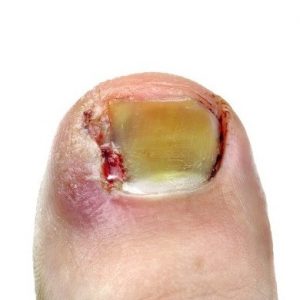 An ingrown toenail is medically diagnosed as onychocryptosis, and it is a highly common problem that, in most cases, affects the large toenail. A typical toenail is supposed to grow in a vertical and or outward position that goes towards the edge of the toe.
An ingrown toenail is medically diagnosed as onychocryptosis, and it is a highly common problem that, in most cases, affects the large toenail. A typical toenail is supposed to grow in a vertical and or outward position that goes towards the edge of the toe.
The main cause for an ingrown toenail is the result of nail growing sideways towards or into the skin of the toe. As the toenail continues to grow abnormally, it will begin pushing all the skin surrounding it, which then results in a lot of pain and discomfort to the owner of the toe.
Symptoms of an Ingrown Toenail
Some of the most commonly reported symptoms for ingrown toenails are painful and sore nails that grow into the skin fold. The surrounding affected skin can have several different degrees of swelling, redness, and in cases where its infected, there can also be clear or yellowish colored drainage.
In most cases you can treat an ingrown toenail on your own without the need for a medical professional. However, prolonged cases or other complicated factors (such as being a diabetic) could result in you needing to see a physician or podiatrist right away.
How are Ingrown Toenails Caused?
As the abnormal growing section of the nails continues to grow it begins to attack the body (toe) by poking or pinching off tiny pieces of the skin located on the outer side of the toe. When the poking and pinching occur, this causes the skin to break which then results in lots of inflammation and the potential for infection.
As the body tries to heal itself, the nail skin will begin to form thicker trying to keep the “foreign object” (the ingrown nail) from penetrating even further. As a result, this creates a further problem. The longer it goes untreated the more the piece of nail will push through the skin resulting in more pain and higher risks for infection.
Ingrown toenails generally only happen to the big toe. However, there is still the possibility of this happening to your smaller toes and even your fingernails in some situations.
What Creates an Infected Ingrown Toenail?
The fungi and bacteria present at the time can quite quickly infect both the skin and the nail on the toe. Because feet are very warm and moist most of the time, it is the ideal environment for infections to develop.
Some of the infections could be Candida, Trichophyton, Pseudomonas, and Staphylococcus. This is why it is very important to treat your ingrown toenail right away.
If you notice signs of infection you should stop home remedies and reach out to a doctor.
If after trying solutions on your own for a few days with little or no success you might be better off speaking with a medical professional about your ingrown toenail.
When not treated ingrown toenails can result in much more complex infections including celluitis. It can also result in scarring of the nail skin and even result in the need to remove the toenail altogether.






